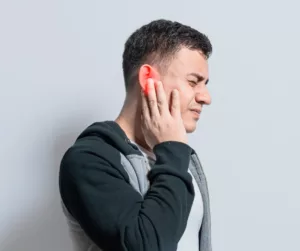Types of Tinnitus: What You Need to Know
Tinnitus affects 15% to 20% of people, manifesting as ringing, buzzing, or other sounds in the ears. The noise, not caused by external sources, varies in duration and type. So exploring the different types of tinnitus sounds helps in understanding this common issue. While some hear a high-pitched ringing, others describe it as buzzing or clicking. Often linked to age-related hearing loss or inner ear injury, understanding the anatomy of tinnitus sounds aids in pinpointing its cause and seeking treatment. Whether you experience it momentarily after a concert or chronically, knowing the types of tinnitus is essential.
Understand more about age related hearing loss.
What Are the Different Types of Tinnitus?
Tinnitus, a condition where individuals perceive phantom sounds, is not one-size-fits-all. In fact, it’s categorized into multiple types, each with its own defining characteristics and causes. Individuals and healthcare professionals can better navigate treatment options by delineating these categories. Here’s a deeper dive into the prevalent types of tinnitus:
Subjective Tinnitus
- Definition: This type of tinnitus is perceived only by the individual affected. It accounts for more than 99% of all tinnitus cases.
- Characteristics: The sounds, ranging from ringing to humming, aren’t caused by external sources. They might follow exposure to loud noises, like concerts or construction sites.
- Duration: Can be short-lived or persist over 12 months. Fluctuations and severity differ.
- Causes: Often results from auditory and neurological responses to hearing loss, though other factors might play a role.
Objective Tinnitus
- Definition: A rare form, detectable by others, including doctors. Represents less than 1% of tinnitus cases.
- Characteristics: Arises from conditions affecting nearby ear structures. Can be tied to one’s heartbeat rhythm.
- Detection: Often found during ear examinations. Sounds might be faint but are discernible with instruments like a stethoscope.
- Causes: Typically related to involuntary muscle contractions or vascular abnormalities.
Less Common Types of Tinnitus:
Pulsatile Tinnitus
- Definition: A rhythmic sound, often in sync with the individual’s heartbeat.
- Characteristics: Might sound like a swooshing or whooshing, stemming from no external source. It affects nearly five million Americans and can lead to depression or anxiety due to its persistence.
- Causes: Often tied to vascular tumors, blood vessel disorders like atherosclerosis, or pressure build-up within the skull.
Neurological Tinnitus
- Definition: Resulting from conditions impacting the brain’s auditory functions.
- Characteristics: Makes hearing clearly challenging.
- Causes: Diseases like Meniere’s, which targets the middle ear, result in symptoms like dizziness, nausea, and tinnitus.
Somatic Tinnitus
- Definition: Connected to the sensory system and influenced by movement or touch.
- Characteristics: Triggered by spasms or mechanical disruptions in the head and neck.
- Causes: Ranges from inflammation, dental procedures, injuries to posture issues.
Special Mention: Other Subtypes
- Musical Tinnitus: Perceived as hallucinations or musical imagery.
- Low-frequency tinnitus: is a droning or deep mumbling sound with unclear origins.
Understanding the type of tinnitus one experiences is crucial for appropriate treatment and management.

Understanding the Types of Tinnitus Sounds
It’s not just about hearing a simple buzz or ring; the sounds can vary greatly in nature and intensity. Let’s delve deeper into the characteristics and significance of these phantom sounds:
Characteristics of Tinnitus Sounds
- Variability: The sounds of tinnitus can intertwine, change, and range from crickets to dial tones, even music.
- Objective vs. Subjective: Sounds might be perceivable solely to the individual (subjective) or others too (objective). The former is far more common.
- Sound Intensity: Noise levels can fluctuate, becoming pronounced during quiet times, like at night, leading to stress and possibly insomnia.
- Location: While usually in both ears, tinnitus can shift from ear to ear or feel centralized “in the head.”
The Significance of Tinnitus Sounds
Understanding the specific sound of your tinnitus is crucial. Not only can it hint at potential underlying conditions, but it also guides medical evaluations and treatments. For instance:
- Pulsating Tinnitus: When isolated to one ear and linked to a vascular issue, it might be more concerning than a high-frequency sound in both ears. Consequently, unilateral tinnitus generally warrants a medical assessment more than its bilateral counterpart.
- Changing Sounds: A shift in tinnitus sound could indicate various factors. An elevated volume might stem from benign causes like stress or exposure to loud noises. Yet, it could also be due to earwax blockages, infections, hearing decline, or other treatable conditions.
What Are the Types of Tinnitus Sounds?
Tinnitus manifests as a range of auditory perceptions, each with its distinct characteristics. Let’s explore the diverse types of tinnitus sounds.
- Ringing: This is perhaps the most frequently described tinnitus sound. It’s a high-pitched tone similar to a telephone or bell ringing.
- Buzzing: A steady sound pattern that can be likened to the buzzing of an insect or an electrical device.
- Hissing: This sound mirrors that of steam or air escaping from a small opening and is often continuous.
- Humming: A constant, low-pitched sound reminiscent of machinery or some electrical appliances when they are operating.
- Clicking: This manifests as brief, intermittent tick-like sounds, akin to a switch being turned on and off repeatedly.
- Roaring: A more intense and enveloping sound can sometimes be associated with conditions like Meniere’s Disease.
- Pulsating: Standing apart from the other types, this rhythmic sound often mirrors the individual’s heartbeat. Unique in nature, pulsatile tinnitus can sometimes be perceived by someone near the affected individual, especially in quiet environments.
While tinnitus is often benign, the particular sounds, their causes, and characteristics play a pivotal role in treatment decisions. Recognizing and understanding these sounds is the first step toward effective management and potential relief.
Treatment Options: From Sound Therapy to Medication
Tinnitus, though lacking a definitive cure, has a wide range of management strategies. Here’s a breakdown of available treatments, which can vary based on the specific type of tinnitus.
Informational and Educational Counseling
- Overview: Aimed at patients with persistent tinnitus, this approach provides specific information about tinnitus, potential treatments, and guidance on dubious online claims.
- Application: Counseling may be beneficial for both the patient and their support system. It may also necessitate professional referrals to handle tinnitus’s psychological effects.
Cognitive Behavioral Therapy (CBT)
- Overview: A psychotherapeutic approach, CBT seeks to modify emotions, thoughts, and behaviors linked to tinnitus.
- Application: Particularly useful for patients facing distress, CBT helps reduce negative reactions, enhancing the patient’s life quality.
Hearing Aids
- Overview: Properly fitted hearing aids can reduce tinnitus for individuals, especially those with hearing loss.
- Application: They amplify external sounds, making tinnitus less obtrusive, and can be combined with sound generators for a comprehensive effect.
Learn more about using hearing aids for tinnitus.
Sound Therapy
- Overview: Utilizes sound to ease tinnitus, ranging from wearable devices emitting soft sounds to environmental devices providing background noise.
- Application: These strategies help mask, habituate, or neuromodulate tinnitus, offering continuous relief throughout the day.
Tinnitus-Specific Management Programs
- Overview: These are structured programs catering to specific types of tinnitus.
- Tinnitus Retraining Therapy (TRT): A habituation-based approach focused on directive counseling and sound therapy.
- Progressive Tinnitus Management (PTM): Focuses on self-management of negative reactions.
- Tinnitus Activities Treatment: An individualized counseling approach that integrates sound therapy and patient activities.
Alternative Tinnitus Management Options
There are multiple alternative treatments, each requiring careful consideration of evidence backing their efficacy.
- Biofeedback Training: Teaches voluntary control over physiological responses.
- Hypnotherapy: Uses an altered consciousness state to bring about subconscious change.
- Myofascial Trigger Point Therapy: Targets muscle contractions near the ear for tinnitus patients with chronic pain.
- Neuromodulation: Uses therapeutic sound presentations.
- Psychotherapy: Covers mindfulness training and relaxation techniques.
- Transcranial Magnetic Stimulation: A non-invasive procedure stimulating nerve cells.
- Vagus Nerve Stimulation: Uses an electrical stimulator in conjunction with audio therapy.
The selection of tinnitus treatment often depends on its type and individual experiences. It is vital to explore and understand the available options and their suitability for specific tinnitus types.

Finding Expert Guidance and Support
Tinnitus can be a subtle whisper or a disruptive roar in one’s ears. Its types of tinnitus sounds, ranging from a soft humming to a rhythmic pulsating, are as varied as those who experience it. But amidst this diversity lies a universal truth: for many, tinnitus significantly influences daily life.
Decoding the different types of tinnitus, understanding the specific sounds, and being familiar with available treatments are fundamental steps to demystifying this prevalent auditory condition. It’s not just about identifying the noise; it’s about comprehending its root, navigating its complexities, and seeking solace through informed decisions.
If tinnitus affects your world, you’re not alone. A community of experts, like those at your local American Hearing and Audiology center, is ready to guide, support, and offer solutions. Seek the silence you deserve. Schedule a consultation with American Hearing and Audiology today and embark on your journey towards a more peaceful future.



